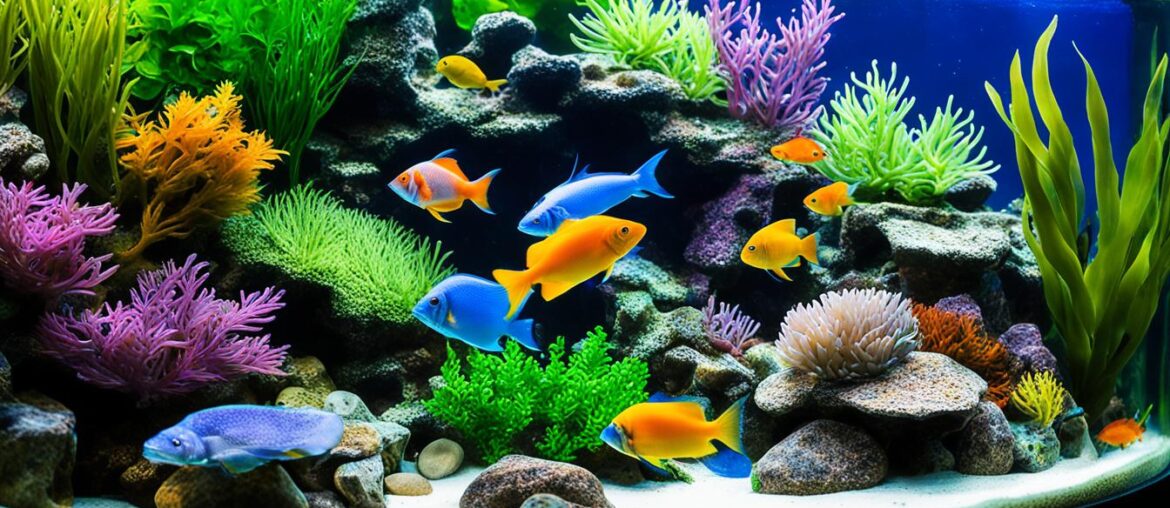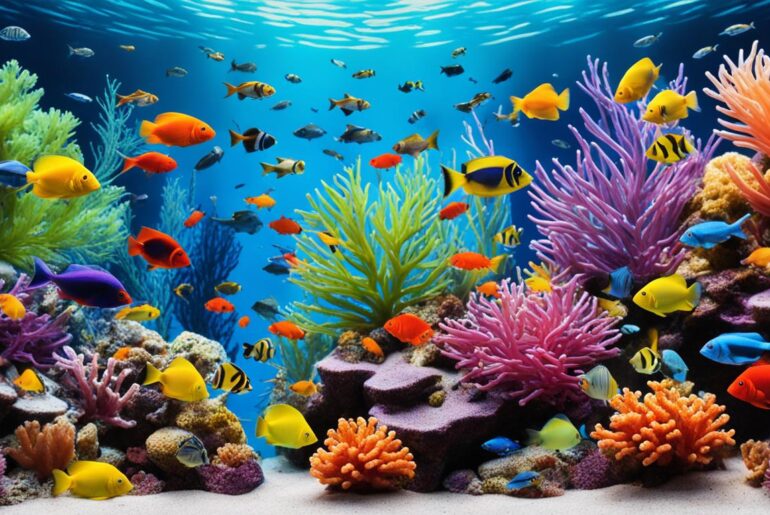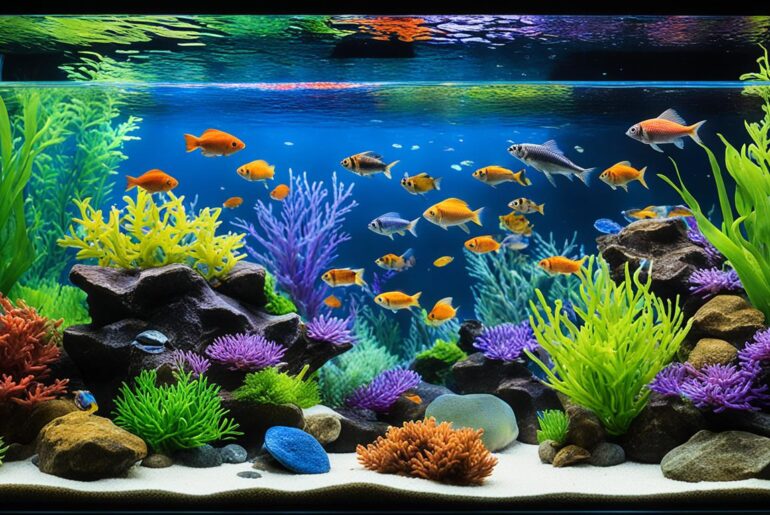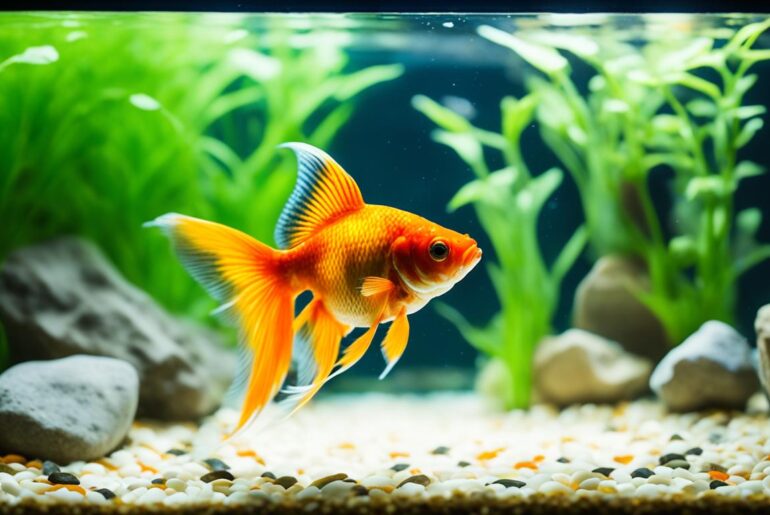Have you ever wondered how many fish you can safely keep in your home aquarium? Are you unsure of the optimal stocking levels for your tank? The quest for achieving maximum stocking density in home aquariums is a common concern among fish owners. But fear not, because I have the answers you’re looking for. In this comprehensive guide, we will explore the factors to consider and methods for calculating safe stocking levels in your aquarium. Get ready to unlock the secrets to creating a thriving aquatic ecosystem right in your own home.
Key Takeaways:
- Understanding the factors to consider when stocking an aquarium
- The limitations of the one inch of fish per gallon rule
- Using the surface area rule to determine stocking levels
- The importance of researching fish species before making a purchase
- Adjusting stocking levels based on tank size and water volume
Factors to Consider for Stocking an Aquarium
When stocking an aquarium, there are several important factors that need to be taken into consideration. These factors play a crucial role in determining the maximum stocking capacity suitable for a home aquarium. Let’s explore each of these factors in detail.
Aquarium Size
The size of the aquarium is a fundamental factor when determining stocking capacity. The larger the aquarium, the more fish it can accommodate. A bigger tank provides more space and allows for better water circulation, which is essential for maintaining a healthy environment for the fish.
Fish Size
The size of the fish is another important factor to consider. Some fish species grow larger than others, and they require more space as they mature. It’s crucial to research the adult size of the fish species you plan to keep and ensure that your tank can accommodate their growth adequately.
Fish Behavior
The behavior of the fish is a critical factor in determining stocking capacity. Some fish are more territorial and aggressive, requiring more space to establish their territories. On the other hand, peaceful and schooling fish can be kept in larger numbers as they tend to coexist harmoniously.
Filtration System
An efficient filtration system is essential for maintaining water quality in the aquarium. The filtration system helps remove toxins and waste produced by the fish. It’s important to consider the capacity and effectiveness of the filtration system when determining stocking levels.
Surface Area of the Water
The surface area of the water is often overlooked but plays a vital role in oxygen exchange and overall fish health. A larger surface area allows for better oxygen exchange, which is crucial for the well-being of the fish. It’s important to consider the tank’s shape and ensure that it provides an adequate surface area for the fish.
By considering these factors – aquarium size, fish size, fish behavior, filtration system, and surface area of the water – you can determine the maximum stocking density suitable for your home aquarium. Each factor contributes to creating a balanced and thriving ecosystem for your fish.
The One Inch of Fish per Gallon Rule
The one inch of fish per gallon rule is a commonly used guideline for determining stocking levels in home aquariums. This rule suggests that for every gallon of water in the tank, you can add one inch of fish. However, it’s important to understand the limitations of this rule and consider other factors when stocking your aquarium.
Limitations of the One Inch Rule:
- Fish Waste Production: The one inch rule doesn’t account for the amount of waste produced by the fish. Larger-bodied fish tend to produce more waste, requiring a larger volume of water to dilute and maintain water quality.
- Fish Size and Shape: Fish come in various sizes and body shapes. The one inch rule fails to consider the specific needs of different fish species. Some species may have larger adult sizes, even if they are only one inch when purchased.
- Activity Level: The activity level of fish is another crucial factor to consider. Active and schooling fish require more space to swim and thrive. The one inch rule doesn’t account for the behavioral needs of fish.
To illustrate the limitations of the one inch rule, let’s consider an example. Imagine you have a 10-gallon aquarium and you want to stock it with fish. Following the one inch rule, you could add ten one-inch fish. However, if these fish are large-bodied and produce a significant amount of waste, the tank may become quickly overwhelmed.
Example Calculation:
Aquarium Size: 10 gallons
Fish Size: 1 inch each
Fish Waste Production: HighLimitations: Larger-bodied fish produce more waste and require more water volume for dilution.
As you can see, the one inch rule alone may not be sufficient to establish appropriate stocking levels for your aquarium. It’s important to consider the specific needs of the fish species you plan to keep and ensure they have adequate space and water volume to thrive.
Before stocking your aquarium, take the time to research the adult size and behavior of the fish species you’re interested in. This will help you make informed decisions about the number and size of fish you should add to your tank.
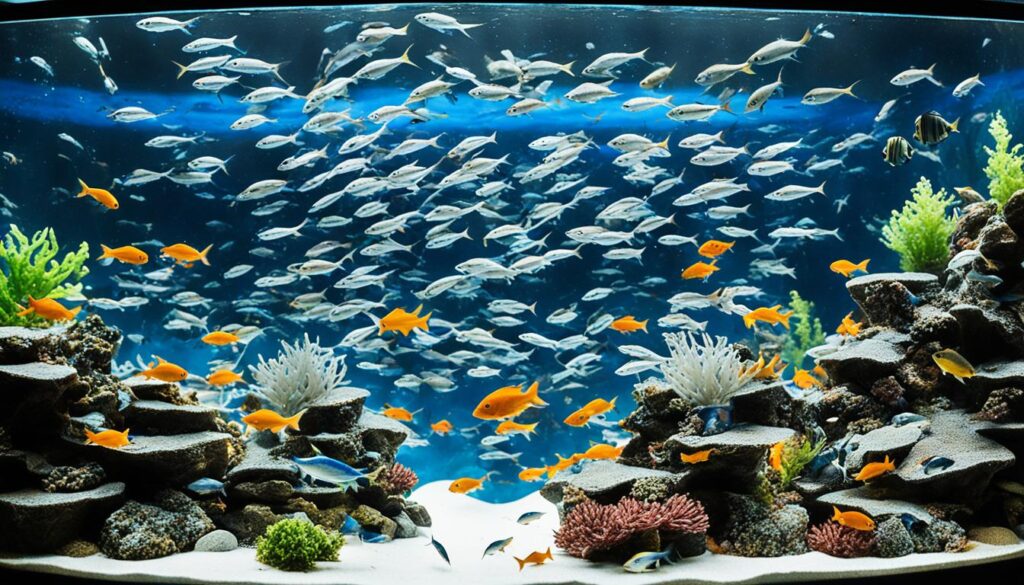
Comparison of Fish Stocking Rules
| Stocking Rule | Advantages | Limitations |
|---|---|---|
| The One Inch of Fish per Gallon Rule | – Simple guideline – Easy to calculate |
– Doesn’t consider fish waste production – Doesn’t consider fish size and shape – Doesn’t consider activity level |
| The Surface Area Rule | – Considers tank shape and surface area – Accommodates wide-bodied and slender-bodied fish |
– Requires additional calculations – Doesn’t consider other factors like waste production |
The Surface Area Rule
Apart from the one inch of fish per gallon rule, another method for calculating stocking levels is the surface area rule. This rule takes into account the surface area of the water, which directly impacts oxygen exchange and the number of fish that can be kept in the tank.
Unlike the one inch rule, the surface area rule also considers the shape of the tank. Different tank shapes can affect the available surface area. For example, wide-bodied fish require more surface area to swim and breathe comfortably, while slender-bodied fish may require less.
When applying the surface area rule, it is crucial to adjust the calculation based on the body shape of the fish. This ensures that the fish have enough space to thrive and maintain optimal health within the tank.
| Fish Body Shape | Surface Area Requirement |
|---|---|
| Wide-bodied fish | Require more surface area |
| Slender-bodied fish | May require less surface area |
By considering the surface area of the water and adapting the stocking levels accordingly, fish owners can create a well-balanced and suitable environment for their aquatic companions.
The Importance of Researching Fish Species
Before purchasing fish for an aquarium, it is crucial to thoroughly research the specific species. This includes understanding the adult size of the fish, its compatibility with other fish, and any special requirements it may have. Tank signage at pet shops can provide valuable information about the adult size of the fish and its compatibility with other species. It is important to use the true adult size of the fish in stocking calculations to avoid overcrowding the tank as the fish grow.
Researching fish species is essential to ensure a harmonious and thriving aquarium ecosystem. By understanding the adult size of the fish, you can prevent your tank from becoming overcrowded. Some fish species may grow much larger than expected, and without proper research, you risk placing them in a tank that cannot accommodate their true adult size.
Additionally, researching fish compatibility is crucial to create a peaceful community tank. Not all fish get along well with each other, and certain species may display aggressive or territorial behavior. By understanding the compatibility of different fish species, you can avoid conflicts and create a harmonious environment for your aquatic pets.
Tank signage at pet shops is a valuable resource for gathering information about fish species. The signage usually provides details about the adult size of the fish, their basic care requirements, and their compatibility with other species. Pay close attention to this information and consider it when selecting fish for your aquarium.
It is also important to consider the special requirements of certain fish species. Some fish may have specific dietary needs, water temperature preferences, or water quality requirements. By researching these special requirements, you can ensure that your fish are kept in optimal conditions and thrive in your aquarium.
Researching fish species is a crucial step in creating a successful and visually appealing aquarium. By understanding the adult size of the fish, their compatibility with other species, and any special requirements they may have, you can make informed decisions and create a balanced and healthy aquatic environment.
Adjusting Stocking Levels for Tank Size and Water Volume
In addition to considering factors such as fish size and behavior, it is important to adjust stocking levels based on the capacity of the tank and its actual water volume. Non-standard tank sizes may hold less water than their advertised volume, and this must be taken into account when determining stocking capacity. It is always better to err on the side of understocking to ensure the health and well-being of the fish.
When determining the stocking levels for your aquarium, it’s crucial to consider the tank capacity and the actual water volume it can hold. Non-standard tank sizes may vary in the actual volume of water they can retain, so relying solely on advertised measurements can lead to overstocking and potentially harm the fish.
Understocking, or keeping fewer fish than the calculated maximum stocking density, is a safer approach for the overall well-being of the fish. It allows for sufficient space, adequate oxygen exchange, and proper waste management within the tank. By keeping fish understocked, you provide them with a less stressful and healthier environment.
Calculating Stocking Levels Based on Tank Capacity
To accurately adjust stocking levels, measure the actual water volume of your tank. This can be done by filling the tank with water and measuring the amount used. Subtract any decorations or substrate from the total volume to determine the net water capacity.
Here’s an example:
| Tank Size | Advertised Volume | Net Water Capacity |
|---|---|---|
| Standard 10-gallon tank | 10 gallons | 8.5 gallons (after accounting for decorations) |
| Non-standard tank | 15 gallons | 12 gallons (after accounting for decorations) |
Once you have determined the net water capacity of your tank, you can calculate the appropriate stocking levels using the guidelines discussed in previous sections.
Importance of Understocking
Understocking your tank is preferable to overcrowding it. Providing ample space for your fish promotes better health, reduces stress, and minimizes the risk of disease outbreaks. It also helps maintain water quality by ensuring efficient filtration and oxygen exchange.
Understocking allows fish to swim and interact more freely, reduces competition for resources, and prevents aggressive behavior caused by overcrowding. Additionally, it enables the filtration system to effectively process waste, keeping the water parameters stable and preventing harmful ammonia and nitrite buildup.
Remember, every tank has a limit to the number of fish it can sustain, based on its size, water volume, and the specific needs of the fish species. Always prioritize the well-being of your fish by adjusting stocking levels according to the actual tank capacity and water volume.
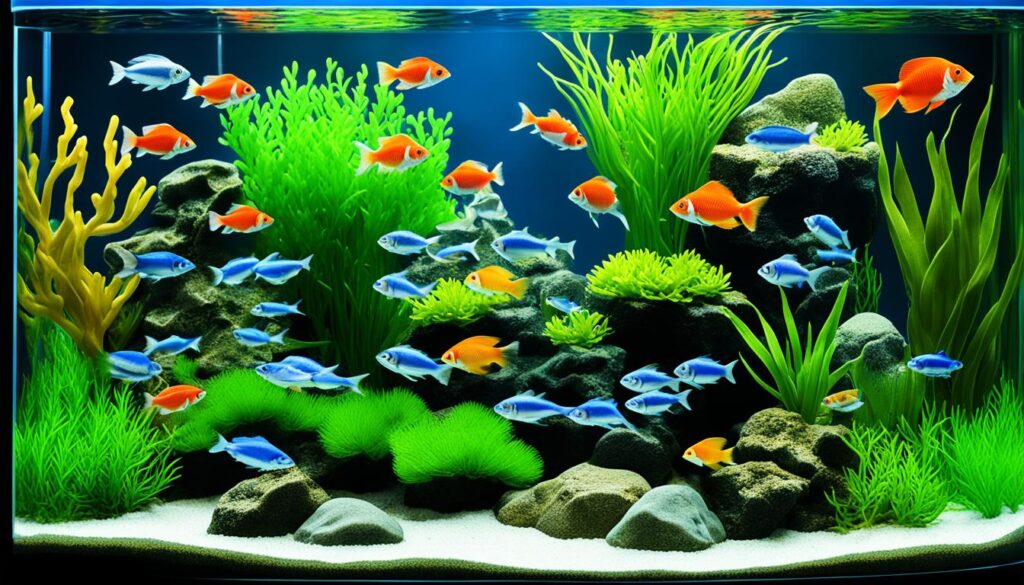
Introducing Fish Gradually and Allowing for Biological Adjustment
When it comes to stocking an aquarium, one key aspect that often gets overlooked is the importance of introducing fish gradually. It’s tempting to fill the tank all at once with our favorite fish, but doing so can have detrimental effects on the health and well-being of our aquatic pets.
Why is it so crucial to introduce fish gradually? The answer lies in the delicate balance of the aquarium ecosystem. Fish waste produces toxins that can be harmful to both the fish and the overall water quality. However, nature has its way of dealing with these toxins through the presence of beneficial bacteria.
I like to think of beneficial bacteria as the unsung heroes of the aquarium. These microscopic organisms form bacterial colonies in the filtration system, where they work hard to break down and neutralize the harmful toxins produced by fish waste.
By introducing fish gradually, we give the bacterial colonies time to adjust to the increased bio-load and establish themselves in sufficient numbers. This allows them to effectively process the waste toxins, maintaining a healthy environment for our fish to thrive.
So how do we go about introducing fish gradually? A good rule of thumb is to avoid adding more than 25 percent of the total volume of fish to the aquarium at one time. This gradual approach gives the bacterial colonies a chance to adjust to the new bio-load without becoming overwhelmed.
It’s also important to ensure that our filtration system has the capacity to handle the waste produced by the fish. A properly sized and functioning filtration system is essential for maintaining optimal water quality. Regular maintenance and monitoring of the filtration system’s capacity are key to a healthy aquarium ecosystem.
By following these guidelines and introducing fish gradually, we can create a stable and harmonious environment where fish can adjust to changes in bio-load and thrive. So let’s take it slow and give our aquatic friends the best chance for a happy, healthy life.
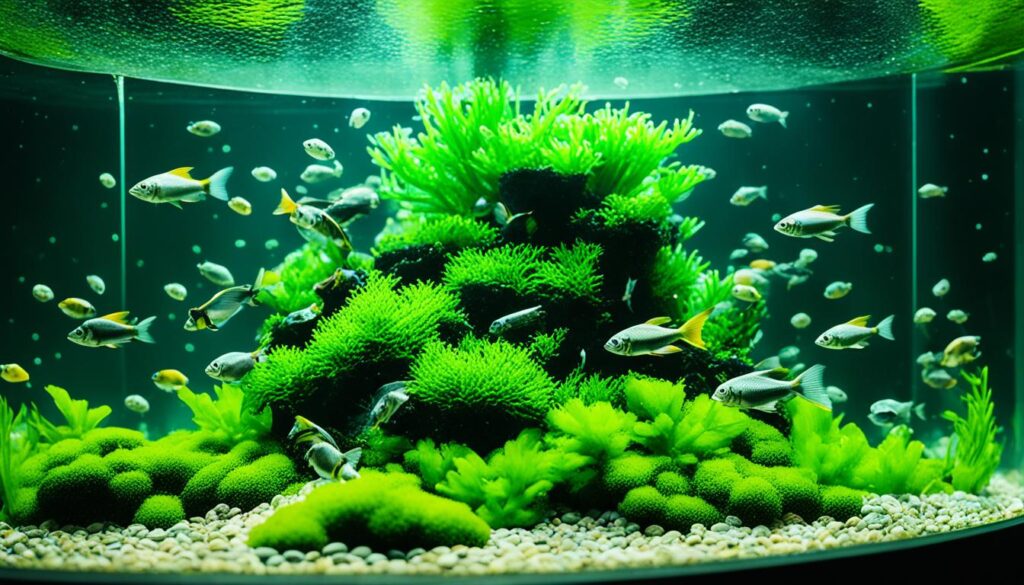
Monitoring Filtration and Oxygen Exchange
Ensuring optimal water quality in your aquarium requires constant monitoring of the filtration system’s capacity and the oxygen exchange within the tank. These factors play a crucial role in maintaining a healthy environment for your fish. To promote the well-being of your aquatic pets, here’s what you need to know:
Filtration System Capacity
The capacity of your filtration system determines its ability to remove toxins and waste from the water. To ensure effective filtration, it is recommended to have a filter that can process four times the total volume of water in the tank per hour. This over-filtering technique helps maintain water clarity and prevents the buildup of harmful substances.
Oxygen Exchange and Water Volume Circulation
Oxygen exchange is essential for the survival of fish. Enhancing the oxygen exchange within the aquarium ensures that your fish receive an adequate supply of oxygen to thrive. The surface area of the water and the shape of the tank play a significant role in this process. A larger surface area allows for greater oxygen transfer between the water and the air.
To improve oxygen exchange, consider the following:
- Choose a tank shape that maximizes the surface area, such as rectangular or square tanks.
- Ensure proper water volume circulation through the use of appropriate pumps or powerheads.
- Position any decorations or plants in the aquarium in a way that minimizes obstruction to water flow.
By maximizing oxygen exchange, you provide your fish with the necessary oxygen levels to support their health and vitality.
Maintaining Water Quality through Monitoring
To maintain optimal water quality, it is important to conduct regular checks on the filtration system’s capacity and the overall health of the aquarium. Regularly inspect the condition of the filter media and clean or replace it as necessary. Keep an eye out for any signs of excessive waste accumulation or reduced water flow, as these may indicate a need for maintenance or adjustment.
Additionally, monitor the oxygen levels in the tank using appropriate testing kits. Low oxygen levels can lead to stress and potential health issues for your fish.
The Importance of Avoiding Over-Filtering
While it is crucial to ensure adequate filtration, it is equally important to avoid over-filtering your aquarium. Over-filtering occurs when the flow rate of the filtration system is too strong, causing excessive disturbances in the water. This can lead to stress and discomfort for your fish.
Be mindful of the specific needs of your fish species and adjust the filtration system accordingly. Strike a balance to maintain water quality without creating excessive water movement that may disrupt the well-being of your fish.
Remember, maintaining the right balance of filtration and oxygen exchange is key to creating a thriving aquatic environment for your fish.
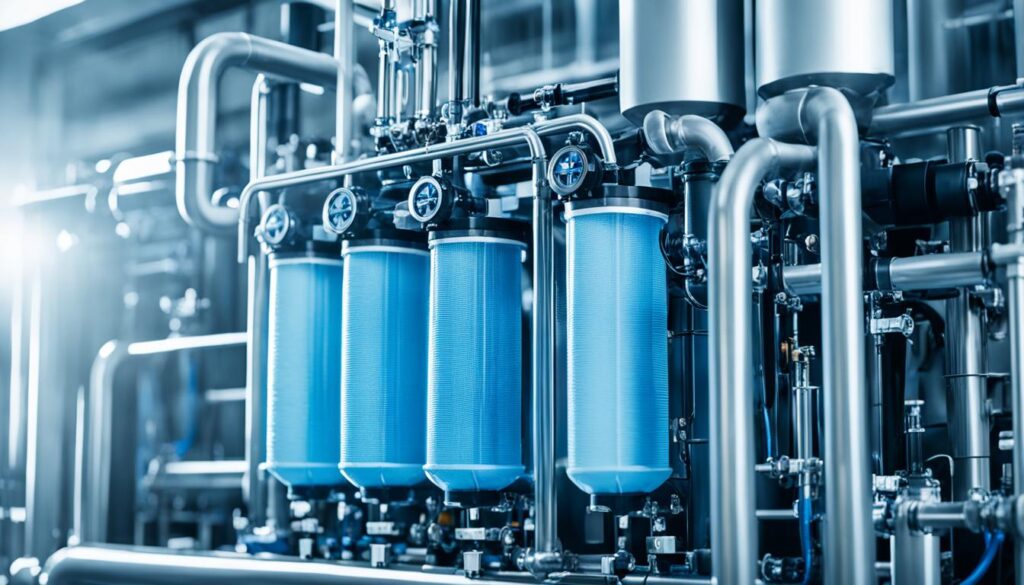
| Benefits of Monitoring Filtration and Oxygen Exchange | Tips for Maintaining Water Quality |
|---|---|
| 1. Prevents toxin buildup | 1. Regularly inspect and clean the filtration system |
| 2. Supports fish health and well-being | 2. Monitor water flow and adjust as needed |
| 3. Reduces stress and potential health issues | 3. Conduct regular tests for oxygen levels |
| 4. Creates a thriving aquatic environment | 4. Strike a balance between filtration and oxygen exchange |
Conclusion
In conclusion, maintaining a healthy and vibrant aquarium ecosystem with optimal stocking levels requires careful consideration of various factors. By taking into account the size of your aquarium, the size and behavior of your fish, the efficiency of your filtration system, and the surface area of the water, you can ensure the well-being of your aquatic pets.
Thorough research on different fish species is crucial to understand their adult size, compatibility with other fish, and any special requirements they may have. This information will help you make informed decisions when stocking your aquarium and avoid overcrowding.
It is important to adjust stocking levels based on the capacity of your tank and its actual water volume. Non-standard tank sizes may hold less water than advertised, so it’s always better to understock to prevent overcrowding and maintain a healthy environment for your fish.
Additionally, introducing new fish gradually allows the beneficial bacteria in your filtration system to adjust to the increased bio-load, ensuring effective waste processing. Monitoring the capacity of your filtration system and maintaining proper oxygen exchange are vital for the overall health and longevity of your aquatic pets. With proper care and attention, you can achieve optimal stocking levels and enjoy a thriving and beautiful aquarium in your home.
FAQ
What factors do I need to consider when stocking an aquarium?
When stocking an aquarium, it is important to consider factors such as the size of the aquarium, the size and behavior of the fish, the efficiency of the filtration system, and the surface area of the water.
What is the one inch of fish per gallon rule?
The one inch of fish per gallon rule is a commonly used guideline for determining stocking levels in home aquariums. However, it is important to recognize its limitations and consider other factors such as fish waste production, fish size and shape, and the activity level of the fish.
How does the surface area rule affect stocking levels?
The surface area rule takes into account the surface area of the water, which impacts oxygen exchange and the number of fish that can be kept in the tank. It considers the shape of the tank and adjusts stocking levels based on the body shape of the fish.
Why is it important to research fish species before stocking an aquarium?
Thoroughly researching fish species is crucial to understanding their adult size, compatibility with other fish, and any special requirements they may have. Tank signage at pet shops can provide valuable information about adult fish size and compatibility.
How should I adjust stocking levels based on tank size and water volume?
It is important to adjust stocking levels based on the actual water volume of the tank, as non-standard tank sizes may hold less water than advertised. It is always better to err on the side of understocking to ensure the health and well-being of the fish.
Should I introduce all the fish to the aquarium at once?
It is recommended to introduce fish gradually and not fully stock the tank all at once. This allows time for the beneficial bacteria in the filtration system to adjust to the increased bio-load and effectively process the toxins produced by fish waste.
Why is monitoring filtration and oxygen exchange important?
The capacity of the filtration system is essential for maintaining water quality in the aquarium. It is recommended to have a filter that can process four times the total volume of water in the tank per hour. Additionally, the surface area of the water and the tank’s shape play a role in oxygen exchange, which directly impacts the number of fish that can be kept in the aquarium.
